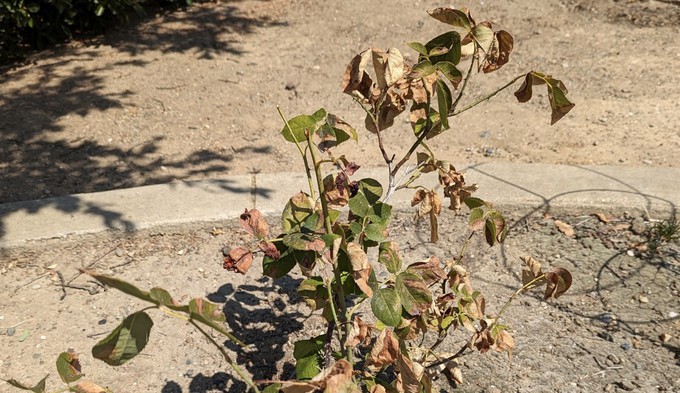
Check drip system is working when plant shows sign of dehydration

This poor Oklahoma hybrid tea rose bush needs some water, and stat! Photo courtesy reader Brent T.
Brent sent a photo for diagnosis. His rose issues stemmed from what could not be seen – and serves as a reminder: Don’t assume a plant is getting enough water just because it’s on drip irrigation. Emitters can become clogged or fail. Roots can interrupt drip lines. (So can critters!)
When a rose or other plant shows signs of dehydration and distress, check the soil. If it’s dry and cracked on top, it definitely has irrigation issues. If you can’t plunge a 6-inch screwdriver into the dirt, it’s time to deep water.
“Give this poor bush some water quick!” I advised Brent after seeing the bush’s photo. “It's sunburned and badly dehydrated. It may also be suffering from foliage burn (which is different from sunburn).
“It also looks like it's infested with spider mites, another sign of dry and dusty conditions.”
Brent confirmed that the bush was on drip irrigation and that likely was the root of the problem.
But how do you return the plant to health?
Start by washing the bush off with a hose; spray it all over to clean off the dust and knock off the little webs of the spider mites.
Then, give the bush a deep and thorough soaking. Saturate its bed, then let the water soak into the ground.
Next, cover the ground with wood chips, bark, dried leaves or other organic mulch (not rocks). That will help keep the soil and roots cooler while retaining moisture.
Sunburn usually happens when bushes are exposed to too much blasting heat – that’s common in Sacramento and especially affects plants growing near concrete driveway, walls or sidewalks. That hardscape reflects more heat. A sunburned bush will shed damaged leaves and recover, as long as it has enough water.
Foliage burn happens when time-release or other fertilizer is introduced to the soil and there's not enough water for the roots to process it. The plant pulls moisture out of its foliage and sends it to the roots so it can pick up those nutrients. But in the process, the foliage looks burned – it's crispy and brown. If you use time-release fertilizer, soil needs to stay evenly moist. (Mulch helps with that, too.) Always deep water BEFORE adding fertilizer and feeding plants.
With a little TLC, water and mulch, Brent’s Oklahoma should be good as new.
Comments
0 comments have been posted.Sacramento Digs Gardening to your inbox.
Sites We Like
Garden Checklist for week of July 21
Your garden needs you!
* Keep your vegetable garden watered, mulched and weeded. Water before 8 a.m. to reduce the chance of fungal infection and to conserve moisture.
* Feed vegetable plants bone meal, rock phosphate or other fertilizers high in phosphate to stimulate more blooms and fruiting. (But wait until daily high temperatures drop out of the 100s.)
* Don’t let tomatoes wilt or dry out completely. Give tomatoes a deep watering two to three times a week.
* Harvest vegetables promptly to encourage plants to produce more. Squash especially tends to grow rapidly in hot weather. Keep an eye on zucchini.
* Pinch back chrysanthemums for bushy plants and more flowers in September.
* Remove spent flowers from roses, daylilies and other bloomers as they finish flowering.
* Pinch off blooms from basil so the plant will grow more leaves.
* Cut back lavender after flowering to promote a second bloom.
* It's not too late to add a splash of color. Plant petunias, snapdragons, zinnias and marigolds.
* From seed, plant corn, pumpkins, radishes, winter squash and sunflowers.